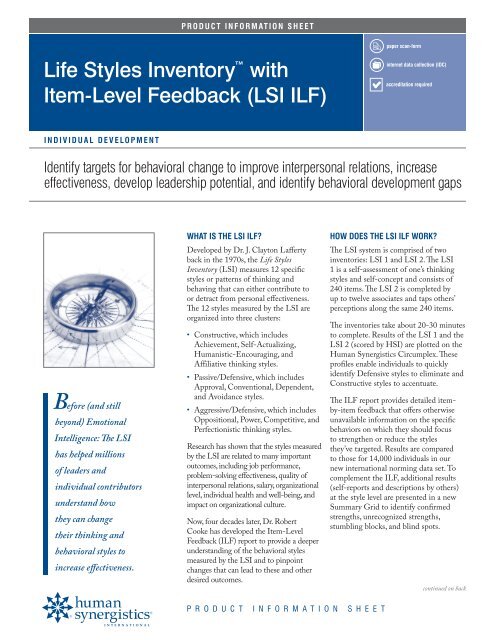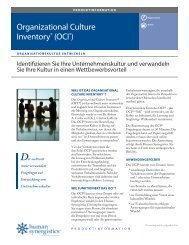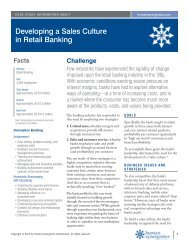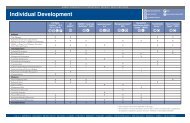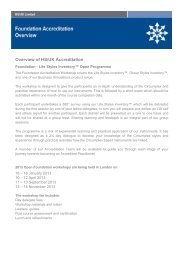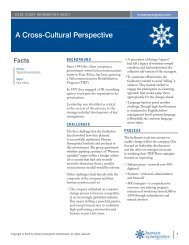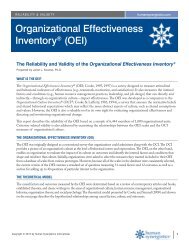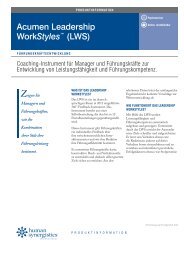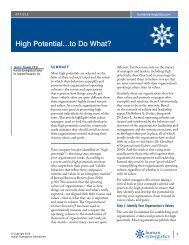LSI ILF - Human Synergistics
LSI ILF - Human Synergistics
LSI ILF - Human Synergistics
Create successful ePaper yourself
Turn your PDF publications into a flip-book with our unique Google optimized e-Paper software.
Product Information Sheet<br />
Life Styles Inventory with<br />
Item-Level Feedback (<strong>LSI</strong> <strong>ILF</strong>)<br />
paper scan-form<br />
internet data collection (IDC)<br />
accreditation required<br />
INDIVIDUAL DEVELOPMENT<br />
Identify targets for behavioral change to improve interpersonal relations, increase<br />
effectiveness, develop leadership potential, and identify behavioral development gaps<br />
Before (and still<br />
beyond) Emotional<br />
Intelligence: The <strong>LSI</strong><br />
has helped millions<br />
of leaders and<br />
individual contributors<br />
understand how<br />
they can change<br />
their thinking and<br />
behavioral styles to<br />
increase effectiveness.<br />
What is the <strong>LSI</strong> <strong>ILF</strong>?<br />
Developed by Dr. J. Clayton Lafferty<br />
back in the 1970s, the Life Styles<br />
Inventory (<strong>LSI</strong>) measures 12 specific<br />
styles or patterns of thinking and<br />
behaving that can either contribute to<br />
or detract from personal effectiveness.<br />
The 12 styles measured by the <strong>LSI</strong> are<br />
organized into three clusters:<br />
• Constructive, which includes<br />
Achievement, Self-Actualizing,<br />
<strong>Human</strong>istic-Encouraging, and<br />
Affiliative thinking styles.<br />
• Passive/Defensive, which includes<br />
Approval, Conventional, Dependent,<br />
and Avoidance styles.<br />
• Aggressive/Defensive, which includes<br />
Oppo sitional, Power, Competitive, and<br />
Perfectionistic thinking styles.<br />
Research has shown that the styles measured<br />
by the <strong>LSI</strong> are related to many important<br />
outcomes, including job performance,<br />
problem-solving effectiveness, qual ity of<br />
interpersonal relations, salary, organ izational<br />
level, individual health and well-being, and<br />
impact on organizational culture.<br />
Now, four decades later, Dr. Robert<br />
Cooke has developed the Item-Level<br />
Feedback (<strong>ILF</strong>) report to provide a deeper<br />
understanding of the behavioral styles<br />
measured by the <strong>LSI</strong> and to pinpoint<br />
changes that can lead to these and other<br />
desired outcomes.<br />
How does the <strong>LSI</strong> <strong>ILF</strong> work?<br />
The <strong>LSI</strong> system is comprised of two<br />
inventories: <strong>LSI</strong> 1 and <strong>LSI</strong> 2. The <strong>LSI</strong><br />
1 is a self-assessment of one’s thinking<br />
styles and self-concept and consists of<br />
240 items. The <strong>LSI</strong> 2 is completed by<br />
up to twelve associates and taps others’<br />
perceptions along the same 240 items.<br />
The inventories take about 20-30 minutes<br />
to complete. Results of the <strong>LSI</strong> 1 and the<br />
<strong>LSI</strong> 2 (scored by HSI) are plotted on the<br />
<strong>Human</strong> <strong>Synergistics</strong> Circumplex. These<br />
profiles enable individuals to quickly<br />
identify Defensive styles to eliminate and<br />
Constructive styles to accentuate.<br />
The <strong>ILF</strong> report provides detailed itemby-item<br />
feedback that offers otherwise<br />
unavailable information on the specific<br />
behaviors on which they should focus<br />
to strengthen or reduce the styles<br />
they’ve targeted. Results are compared<br />
to those for 14,000 individuals in our<br />
new international norming data set. To<br />
complement the <strong>ILF</strong>, additional results<br />
(self-reports and descriptions by others)<br />
at the style level are presented in a new<br />
Summary Grid to identify confirmed<br />
strengths, unrecognized strengths,<br />
stumbling blocks, and blind spots.<br />
continued on back<br />
P r o d u c t I n f o r m a t i o n S h e e t
Life Styles Inventory with Item-Level Feedback (<strong>LSI</strong> <strong>ILF</strong>)<br />
Figure 1: Successful Chairman of the Board<br />
Copyright © 1987-2011 by <strong>Human</strong> <strong>Synergistics</strong> International.<br />
All Rights Reserved.<br />
Figure 2: Three Corporate Presidents<br />
who Failed<br />
Applications<br />
The <strong>LSI</strong> can be used as a coaching or<br />
self-development tool to:<br />
• Enhance self-understanding<br />
by promoting reflection on and<br />
conversations about one’s values, beliefs,<br />
and assumptions<br />
• Heighten awareness of untapped or<br />
underdeveloped aspects of thinking<br />
and behavior;<br />
• Strengthen leadership capabilities;<br />
• Sharpen negotiation, time<br />
management, problem-solving, and/or<br />
interpersonal skills<br />
• Improve individual health and<br />
well-being<br />
For system-wide interventions, the<br />
inventory can be used as a tool for:<br />
• Illustrating and discussing the effects<br />
of different personal styles<br />
• Evaluating current approaches to<br />
motivation and coaching<br />
• Promoting more effective management<br />
and leadership strategies by addressing<br />
systemic deficiencies<br />
• Moving toward a more positive and<br />
Constructive interpersonal climate<br />
Organizational development initiatives<br />
can be further guided by our new <strong>LSI</strong><br />
Composite Reports and Comparative<br />
Profiles that present group-level results<br />
and the outcomes attained by the more<br />
Constructive and Defensive members of<br />
the group or organization.<br />
The <strong>LSI</strong> and performance<br />
The <strong>LSI</strong> profiles shown here illustrate<br />
some of the differences between<br />
successful and unsuccessful managers.<br />
Figure 1 is that of a successful Chairman<br />
of the Board of a profitable and<br />
innovative public utility company. The<br />
extensions at the top of this profile<br />
indicate a predomi nantly Constructive<br />
orientation, particularly in the directions<br />
of Self-Actual izing and Achievement.<br />
In contrast, Figure 2 is a composite of<br />
three corporate presi dents who failed<br />
in their jobs. The ex ten sions toward the<br />
bottom of this profile indi cate strong<br />
Defensive orientations, par ticu larly in<br />
the directions of the Avoidance, Op positional,<br />
Power, and Perfectionistic styles.<br />
Copyright © 1987-2011 by <strong>Human</strong> <strong>Synergistics</strong> International.<br />
All Rights Reserved.<br />
continued on next page<br />
P r o d u c t I n f o r m a t i o n S h e e t
Life Styles Inventory with Item-Level Feedback (<strong>LSI</strong> <strong>ILF</strong>)<br />
Figure 1: <strong>LSI</strong> 1 & 2 Summary Grid<br />
Figure 2: Description-by-Others Item by Item<br />
Summary Grid<br />
The Summary Grid presents blind spots,<br />
confirmed strengths, unrecognized<br />
strengths, and stumbling blocks.<br />
Blind Spots: Others disagree with Self<br />
that a Constructive style is strong<br />
or a Defensive style is weak<br />
Confirmed Strengths: Self and Others<br />
Agree that a Constructive style is strong<br />
or a Defensive style is weak<br />
Unrecognized Strengths: Others Disagree<br />
with Self that a Constructive style is weak<br />
or a Defensive style is strong<br />
Stumbling Blocks: Self and Others Agree<br />
that a Constructive style is weak<br />
or a Defensive style is strong<br />
Styles with extreme scores along which<br />
Self and Others either strongly agree<br />
or disagree, if any, fall in the dark gray<br />
cells near the corners. These styles<br />
often warrant the greatest analysis and<br />
attention by individuals and their coaches.<br />
scores (Δs) are provided based on the<br />
individual’s scores minus the median<br />
scores for the norming group. Positive<br />
Δs indicate that the word or phrase is<br />
more like the individual than the average<br />
person, which, for the Defensive styles,<br />
indicate a target for change. Negative Δs<br />
for Constructive items indicate that they<br />
are less like the individual and thus the<br />
behaviors described are potential targets<br />
for development.<br />
Item-by-Item Analysis<br />
The Item-by-Item tables list by style<br />
the scores for the <strong>LSI</strong> items. The Self-<br />
Description tables list the individual’s<br />
own responses to the items associated<br />
with each style in order of the strength<br />
of their relationship to effectiveness (as<br />
reported by <strong>LSI</strong> 2 Description-by-Others<br />
respondents).<br />
The Description-by-Others Item-by-<br />
Item tables reflect others’ perceptions<br />
of the individual. Item scores can range<br />
from 0.00 (essentially unlike you) to 2.00<br />
(like you most of the time). Difference<br />
U.S.A. AUSTRALIA BELGIUM BRITISH ISLES BULGARIA CANADA FINLAND GERMANY HUNGARY JAPAN THE NETHERLANDS NEW ZEALAND ROMANIA SERBIA SOUTH KOREA<br />
humansynergistics.com<br />
HSI v. 1.0<br />
3/2013<br />
Changing the World—<br />
One Organization at a Time ®<br />
Creators of the Organizational Culture Inventory ® , Desert Survival Situation, Life Styles Inventory and Leadership/Impact ® .


